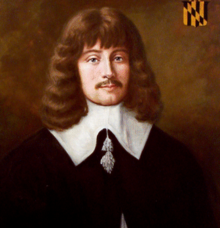Leonard Calvert
Leonard Calvert (1606–9 June 1647) was the First Proprietary Governor of Maryland. He was the second son of George Calvert, 1st Baron Baltimore (1579–1632), the first proprietary of the Province of Maryland. His elder brother Cecil (1605–1675), who inherited the colony and the title upon the death of their father George, 15 April 1632, appointed Leonard as governor of the Colony in his absence. Leonard was named after his grandfather, the father of George who was also "Leonard Calvert" of Yorkshire.

Quotes
edit- There is nothing does more endanger the loss of commerce with the Indians than want of truck to barter with them.
- Cited by Bernard C. Steiner in "Beginnings of the Provincial Trade," in Beginnings of Maryland 1631–1639 (Baltimore, MD: Johns Hopkins Press, 1903), p. 40.
Quotes about Leonard Calvert
edit- [Mary] received the sacrament a year later, when the Tayac gave her to be raised by Governor Leonard Calvert and his sister-in-law, Margaret Brent, so that she could communicate between the two cultures.
- Nora Hamerman, "The birth of American Catholicism," catholicherald.com (1 July 2015).
- The first governor of the colony was Calvert's brother, Leonard, and Calvert appointed a Council to advise his brother. While the Calverts tried to keep representative government to a minimum, an Assembly soon developed, after persistent pressure from below on the proprietors. The proprietor and the Assembly soon quarreled over the extent of their relative powers, the proprietor claiming the sole right to initiate legislation, which the Assembly could then reject. The Assembly, with the power to hold up the enactment of laws, refused to consent to any imposition of a code by Calvert and thus won the fight to initiate legislation.
- Murray N. Rothbard, "Maryland", ch. 12, Pt. II of Conceived in Liberty vol. 1 (Arlington House, 1975), p. 115.
- In the mid-1640s, as the Puritan Revolution arose in England, Lord Baltimore sided with the king, and Leonard Calvert received privileges (or "letters of marque") from the king to capture vessels belonging to Parliament. On the other hand, the Protestant tobacco trader, Capt. Richard Ingle, a friend of Claiborne's, received a similar commission from Parliament. The governor ordered Ingle's arrest for high treason in denouncing the king, whereupon Ingle escaped and in 1645 mounted a successful attack on Maryland. Captain Ingle took the opportunity, "for conscience'" sake, to plunder and pillage "papists and malignants," seizing property and jailing his enemies. The venerable Father Andrew White, a Jesuit missionary who had arrived on the first ships to land in Maryland, was sent to England in irons to be tried for treason. Happily, the old missionary was acquitted.
In the meanwhile, Claiborne took the opportunity to retrieve Kent Island from Maryland's seizure. Under Ingle's attack, Leonard Calvert escaped to Virginia, from where Berkeley helped him to recapture Maryland and Kent Island.
Returning to England, Ingle almost succeeded in revoking Maryland's charter, but Calvert retained it by taking pains to placate Parliament. Calvert, for example, encouraged a group of Dissenters exiled from Virginia to settle in Maryland, a little further up the Chesapeake Bay from St. Marys, in what is now Annapolis. Furthermore, after Leonard Calvert died in 1648, Lord Baltimore appointed the Protestant William Stone as governor.
- Murray N. Rothbard, "Maryland", ch. 12, Pt. II of Conceived in Liberty vol. 1 (Arlington House, 1975), p. 115.
- Here our governour had good advice given him, not to land for good and all, before hee had beene with the Emperour of Paschattoway, and had declared unto him the cause of our coming: which was, first to learne them the divine Doctrine, which would lead their soules to a place of happinesse after this life were ended: and also to enrich them with such ornaments of a civill life, wherewith our Countrey doth abound: and this Emperour being satisfied, none of the inferiour Kings woulde stirre.
- Andrew White, cited by Earl Arnett, Robert J. Brugger, and Edward C. Papenfuse in Tour 2 of Maryland: A New Guide to the Old Line State 2nd ed. (Baltimore, MD: Johns Hopkins University Press, 1999), p. 39.
External links
edit- Calvert Family Tree (accessed 10 Jul 2013)
- Images of Leonard Calvert on the State of Maryland online archives